I would think it is a manufacturing shorcut.
-
Friends, our 2nd Amendment rights are always under attack and the NRA has been a constant for decades in helping fight that fight.
We have partnered with the NRA to offer you a discount on membership and Muzzleloading Forum gets a small percentage too of each membership, so you are supporting both the NRA and us.
Use this link to sign up please; https://membership.nra.org/recruiters/join/XR045103
You are using an out of date browser. It may not display this or other websites correctly.
You should upgrade or use an alternative browser.
You should upgrade or use an alternative browser.
Best 18th Century Military Flintlock Musket
- Thread starter FlinterNick
- Start date

Help Support Muzzleloading Forum:
This site may earn a commission from merchant affiliate
links, including eBay, Amazon, and others.
GregLaRoche
40 Cal
- Joined
- Aug 12, 2019
- Messages
- 206
- Reaction score
- 67
A lot of people mentioned the 1763 Charville, but it is really the French model 1777, that in my opinion, is the best gun produced in the Eighteenth Century. I believe it is the first musket to be produced with all standardized and exchangeable parts. It and it’s variants, would go on to be produced into the Nineteenth Century and become the most produced gun until the First World War.
- Joined
- Nov 1, 2018
- Messages
- 3,840
- Reaction score
- 2,867
A lot of people mentioned the 1763 Charville, but it is really the French model 1777, that in my opinion, is the best gun produced in the Eighteenth Century. I believe it is the first musket to be produced with all standardized and exchangeable parts. It and it’s variants, would go on to be produced into the Nineteenth Century and become the most produced gun until the First World War.
Between the 1763/66 and The 1777 Charleville designs, the 1763/66 is technically the better quality pattern, in my opinion based on Erikson’s book. The USA went on the copy it as the base for the 1795 series of muskets which was also copied by US contractors.
What made the 1763/66 a better quality gun?
One thing to remember is that the 1763 and 1766 are two different muskets with the 1768 being an upgrade of the 66. In 1768 a rear spring was added other subtle differences were made Such as reducing the comb of the stock.
In my opinion, its the lock on the 1766 that is the main quality difference. The 1766 lock under tests performed much better than any French Flintlock System. The 1763 was just as good, but noticeably larger And heavier which required making the stock heavier in the lock area, the larger features just were not necessary.
The other feature of the 1766 that made it a better gun was its overall weight was around 8.5 lbs, compared to the 1763 which was 10.5 lbs and the 1777 which varied between 9.5 - 10 lbs depending on the stock.
Do not forget, TRAINING, a well trained man can make anything work
GregLaRoche
40 Cal
- Joined
- Aug 12, 2019
- Messages
- 206
- Reaction score
- 67
If the French 1766 was the best model, why didn’t they return to something closer to it after experimenting with the 1777 type? Politics? Cost of production?
- Joined
- Nov 1, 2018
- Messages
- 3,840
- Reaction score
- 2,867
If the French 1766 was the best model, why didn’t they return to something closer to it after experimenting with the 1777 type? Politics? Cost of production?
mostly politics, the 1763/66 didnt cost much more than a 77, the cost savings was mostly in the stock design of the 77.
There are reasons and explanations and statistics, and “best” is subjective, but at the end of the day, I will ALWAYS pick a second land pattern Bess over any Continental poodleshooter. Because she’s the best AWI musket *for me*, based on the thousands upon thousands of rounds (live and blank) that I’ve fired from Besses (long, short, India, and sawed-off), Charlevilles, Potsdams, CoS rebuilds and knockoffs, and even the Spanish ‘57. No other musket fits so well, or feels so right.
Jay
Jay
The 95 Springfield is a very slightly modified version of the 1763 Charleville.
I am aware of this, yes yes it is true.
And the best!
- Joined
- Nov 26, 2005
- Messages
- 5,213
- Reaction score
- 10,838
"If the French 1766 was the best model, why didn’t they return to something closer to it after experimenting with the 1777 type? Politics? Cost of production?"
As I wrote previously, the model 1763 and later models probably were technically superior to all other muskets during the 18th century. America adopted the model 1766 (sometimes called model 1763 light) and the 1768 upgrade as the pattern for our first Springfield because we had many of them in stock after the war ready to be copied. They also likely were less costly to produce than the later French models. The French kept developing the model 1777 and improving such that it was probably the finest musket in the world by the 1780s and was very widely copied throughout Europe.
dave
As I wrote previously, the model 1763 and later models probably were technically superior to all other muskets during the 18th century. America adopted the model 1766 (sometimes called model 1763 light) and the 1768 upgrade as the pattern for our first Springfield because we had many of them in stock after the war ready to be copied. They also likely were less costly to produce than the later French models. The French kept developing the model 1777 and improving such that it was probably the finest musket in the world by the 1780s and was very widely copied throughout Europe.
dave
Last edited:
- Joined
- Nov 1, 2018
- Messages
- 3,840
- Reaction score
- 2,867
"If the French 1766 was the best model, why didn’t they return to something closer to it after experimenting with the 1777 type? Politics? Cost of production?"
As I wrote previously, the model 1763 and later models probably were technically superior to all other muskets during the 18th century. America adopted the model 1766 (sometimes called model 1763 light) and the 1768 upgrade as the pattern for our first Springfield because we had many of them in stock after the war ready to be copied. They also likely were less costly to produce than the later French models. The French kept developing the model 1777 and improving such that it was probably the finest musket in the world by the 1780s and was very widely copied throughout Europe.
dave
Never really understood the purpose of the slanted brass pan. Supposedly it was to short rank and file reloading and point the flash forward, however I’ve fired these reproductions and I can’t say that is much more or an improvement over the regular straight pan with a Fence.
I always found the 1777 stock to be somewhat awkward due to its relatively straight profile, I had always assumed they made the come higher and straightened the butt so they could get more cuts out of lumber.
- Joined
- Nov 1, 2018
- Messages
- 3,840
- Reaction score
- 2,867
There are reasons and explanations and statistics, and “best” is subjective, but at the end of the day, I will ALWAYS pick a second land pattern Bess over any Continental poodleshooter. Because she’s the best AWI musket *for me*, based on the thousands upon thousands of rounds (live and blank) that I’ve fired from Besses (long, short, India, and sawed-off), Charlevilles, Potsdams, CoS rebuilds and knockoffs, and even the Spanish ‘57. No other musket fits so well, or feels so right.
Jay
The 1777 short land pattern bess is perhaps one of my most favorite Brown Bess designs. Got to see One at the Yorktown museum. Really nicely designed Bess.
I have one of the replica 1756 (?) Light Infantry muskets. Its several pounds lighter than my Long Land Pattern musket and quite enjoyable to shoot. Mine is in 20 gauge and I would imagine that one in 16 gauge would be even better.
- Joined
- Nov 26, 2005
- Messages
- 5,213
- Reaction score
- 10,838
Hi Grenadier,
You may be referring to the pattern 1760 light infantry carbine:


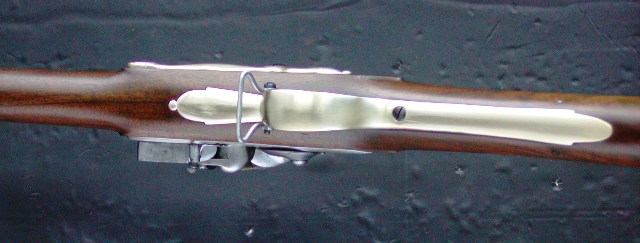

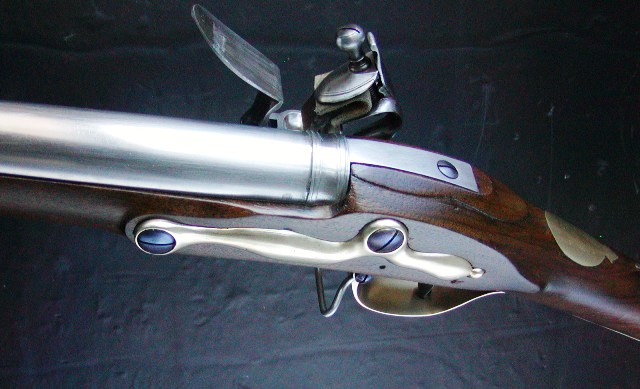
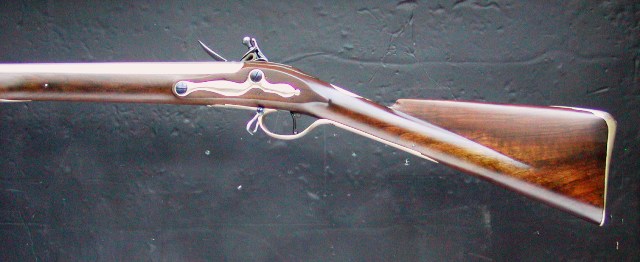
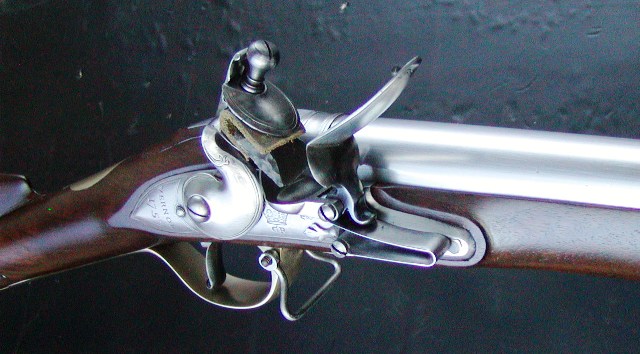
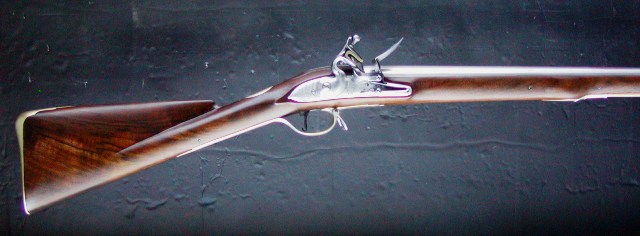

There was an earlier 1745 Lord Loudon pattern somewhat similar but only a few hundred of those were made and few likely were issued to troops in America. The pattern 1760 was too late for the F&I war but was widely issued to light infantry units of all regiments during the first years of the AWI. In fact, since it was lights Bobs engaged at Lexington, the first British shots fired in the war likely came from these carbines. It weighs just under 8 lbs and is nice to shoot except the stock is a bit straight for my build.
dave
You may be referring to the pattern 1760 light infantry carbine:









There was an earlier 1745 Lord Loudon pattern somewhat similar but only a few hundred of those were made and few likely were issued to troops in America. The pattern 1760 was too late for the F&I war but was widely issued to light infantry units of all regiments during the first years of the AWI. In fact, since it was lights Bobs engaged at Lexington, the first British shots fired in the war likely came from these carbines. It weighs just under 8 lbs and is nice to shoot except the stock is a bit straight for my build.
dave
satwel
40 Cal.
It's the Charleville style musket. Following the establishment of Springfield Armory in 1794 the first decision they faced was which musket pattern to adopt. Alternatively, should they design a completely new pattern. Due to their all steel construction and the use of barrel bands, the Charleville patterns supplied by the French during the AWI were deemed more durable than the Brown Bess pattern. David Ames asked other armory superintendents to go through their inventories of Charlevilles, pick the best two or three examples, and send them to Springfield Armory. Springfield Armory picked the best examples from those submitted and declared them the official pattern for the first Springfield production.
- Joined
- Nov 1, 2018
- Messages
- 3,840
- Reaction score
- 2,867
A light infantry fusil is on my list of kit builds
Monkeyman
36 Cl.
I’d give the “best musket” title to either the Charleville 1777 or the Austrian 1784 musket. The Prussian 1740 was known for it’s inaccuracy.Is it the Brown Bess, Charleville, Prussian 1740? There’s almost too many to name, many underdogs on the list.
“the M1740 was one of the more inaccurate weapons of those listed (though this was exacerbated by the use of an undersized ball, relatively to the military load). This reflected the doctrine of the Prussian army, which emphasized speed of fire over accuracy: the greater windage allowed for rapid reloading, even with a heavily-fowled barrel. This trend would only accelerate over the course of the 18th century, with an increase of bore size to 19 mm late in Frederick II's reign. This, and the emphasis on speed over accuracy, also goes a long way to explain in part, the observation that Prussian soldiers typically took more casualties in a firefight than the Austrians did: the Austrian weapons were simply more accurately-aimed. To drive home this point, a test was conducted in 1755 on a target 10 paces across and 10 feet tall (~7x3 meters), with the participants being Prussian Grenadiers.”
“In comparison, the newer muskets used by Scharnhorst in 1813 scored ~44% accuracy at 300 paces, against a company-sized target (1.8x~30 m). A test conducted by Muller with Napoleonic British soldiers produced a minimum accuracy of 18% at 200 yards, and 15% at 300 yards (300 paces would be around 225 yards). Even allowing for the broader (though shorter) target in Scharnhorst's test, the M1740 musket proves remarkably abysmal in the hands of Frederick's soldiers: the lower accuracy, couple with inadequate training in aiming the weapons, combine to produce the above results.”
Source: Prussian Line Infantry Weapons - Project Seven Years War
That being said, I really like the look, so I’m making one
- Joined
- Nov 1, 2018
- Messages
- 3,840
- Reaction score
- 2,867
I’d give the “best musket” title to either the Charleville 1777 or the Austrian 1784 musket. The Prussian 1740 was known for it’s inaccuracy.
“the M1740 was one of the more inaccurate weapons of those listed (though this was exacerbated by the use of an undersized ball, relatively to the military load). This reflected the doctrine of the Prussian army, which emphasized speed of fire over accuracy: the greater windage allowed for rapid reloading, even with a heavily-fowled barrel. This trend would only accelerate over the course of the 18th century, with an increase of bore size to 19 mm late in Frederick II's reign. This, and the emphasis on speed over accuracy, also goes a long way to explain in part, the observation that Prussian soldiers typically took more casualties in a firefight than the Austrians did: the Austrian weapons were simply more accurately-aimed. To drive home this point, a test was conducted in 1755 on a target 10 paces across and 10 feet tall (~7x3 meters), with the participants being Prussian Grenadiers.”
“In comparison, the newer muskets used by Scharnhorst in 1813 scored ~44% accuracy at 300 paces, against a company-sized target (1.8x~30 m). A test conducted by Muller with Napoleonic British soldiers produced a minimum accuracy of 18% at 200 yards, and 15% at 300 yards (300 paces would be around 225 yards). Even allowing for the broader (though shorter) target in Scharnhorst's test, the M1740 musket proves remarkably abysmal in the hands of Frederick's soldiers: the lower accuracy, couple with inadequate training in aiming the weapons, combine to produce the above results.”
Source: Prussian Line Infantry Weapons - Project Seven Years War
That being said, I really like the look, so I’m making one
The Prussian 1740 Musket and its German copies really fit into a generation of muskets used before and during the Seven Years War, like the long lands and early Charlevilles. Once the American Revolutionary War began, the Prussian 1740 really was seen as old and obsolete. British officers incharge of Hessian units outfitted with this musket and other German made arms disapproved of it, especially its compromising polished finish on the barrel. Many of the German arms were discarded for older Brown Bess Muskets or contract muskets. By the time the Napoleonic Wars began, the 1740 was just out done by later period Charleville’s and its copies.
Prussian battle strategies really relied upon the M1740 not needing to be cleaned regularly, in Napoleonic battles french troops didn’t break as easily and french troops were trained to return fire very efficiently. Even in the time of pre-rifled muskets, reliable arms were needed.
- Joined
- Jul 5, 2012
- Messages
- 2,263
- Reaction score
- 3,625
One must consider when looking at the question that 1700-1799 is a considerable time frame in which to compare various muskets. Nations went from nothing standardized to typical patterns. Spanish locks went from miquelet to French and back to miquelet. I have an original Spanish lock and while it is stamped with a crowned R (Royal Ordinance) it is different than everything I have seen that is "official" and after 250 years is still reliable.
Just imagine all of the unique pieces made during the time frame Puckle, Furgeson, Nock just to name a few yet the general feel has been only to mention those in the last half of the century.
My personal choice would be a short escopeta, the miquelet allows for a stronger stock (less inletting) barrel bands secure the barrel tightly. The miquelet will also allow for a poorer quality of flint while maintaining ignition. Shorter allows for easier carrying and basic mobility.
Just imagine all of the unique pieces made during the time frame Puckle, Furgeson, Nock just to name a few yet the general feel has been only to mention those in the last half of the century.
My personal choice would be a short escopeta, the miquelet allows for a stronger stock (less inletting) barrel bands secure the barrel tightly. The miquelet will also allow for a poorer quality of flint while maintaining ignition. Shorter allows for easier carrying and basic mobility.
- Joined
- Apr 7, 2012
- Messages
- 723
- Reaction score
- 956
The 1784 Austrian had two features to increase fire rate. It was self priming. And the ramrod was cylindrical so it not have to be spun around.
The reason given for abandoning the self priming feature was said to be cost, weight, and training. I wonder if safety was not also an issue?
I fail to see why the cylindrical ramrod was not used on every musket that came after. Apparently (according to the video), the Austrians kept that feature in their later muskets. I can see why civilian arms did not use it, but it's advantage for the military seems obvious (to me).
(English subtitles available in settings)
The reason given for abandoning the self priming feature was said to be cost, weight, and training. I wonder if safety was not also an issue?
I fail to see why the cylindrical ramrod was not used on every musket that came after. Apparently (according to the video), the Austrians kept that feature in their later muskets. I can see why civilian arms did not use it, but it's advantage for the military seems obvious (to me).
(English subtitles available in settings)
Last edited:
- Joined
- Nov 1, 2018
- Messages
- 3,840
- Reaction score
- 2,867
The 1784 Austrian had two features to increase fire rate. It was self priming. And the ramrod was cylindrical so it not have to be spun around.
The reason given for abandoning the self priming feature was said to be cost, weight, and training. I wonder if safety was not also an issue?
I fail to see why the cylindrical ramrod was not used on every musket that came after. Apparently (according to the video), the Austrians kept that feature in their later muskets. I can see why civilian arms did not use it, but it's advantage for the military seems obvious (to me).
(English subtitles available in settings)
“I fail to see why the cylindrical ramrod was not used on every musket that came after. Apparently (according to the video), the Austrians kept that feature in their later muskets. I can see why civilian arms did not use it, but it's advantage for the military seems obvious (to me).”
The reason why it was abandoned was because the cost of iron was very expensive, the heavy iron ramrods weighed almost 2 lbs.
Another reason is geometries of the ramrod… if the rammer is bigger, everything else needs to be bigger, the bands, the stock not so much, but the bands would have needed to be adapted to house a heavy loading rod, a rammer spoon or series of guides was also necessary.
It’s really the same reason why the French had abandoned the 1763 series and 1774 series of muskets, the 63’s were heavily stocked and needed larger bands, this was an expensive and poorly received design. The 1774 re-introduced a heavier breeched barrel with larger bands but attempted to reduce the stock stock in the butt and wrist, this proved to be too expensive, the 1777 design was intended to be cheaper than the previous models with two less band springs, a modestly heavier barrel, made practical sense until the screwed on band system failed in the field.
A lot of musket designs are tied to economics of what is available, we take it for granted but small amounts of brass and iron and steel were very expensive.
A great example is the 1746 charleville, which Deleted the pan bridle that was on the previous 1728 model, this was done so they could have more iron to make a few thousand more muskets, and the french were losing the war.
Similar threads
- Replies
- 48
- Views
- 3K
- Replies
- 6
- Views
- 445
- Replies
- 14
- Views
- 1K
- Replies
- 5
- Views
- 719



